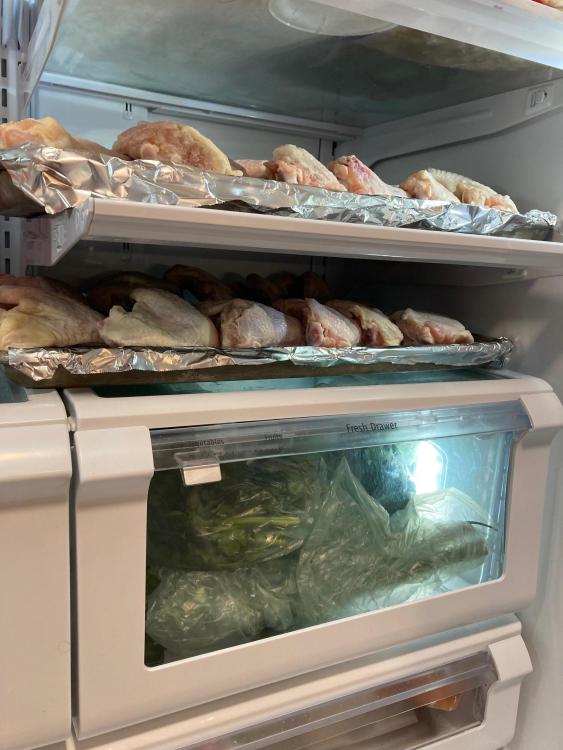-
Posts
8,087 -
Joined
-
Last visited
Content Type
Profiles
Forums
Store
Help Articles
Everything posted by Dave the Cook
-
Done. I also sent an email to their corrections desk, and another that may or may not reach Mr. Asimov.
-
Gorgeous tots.
-
I finally looked at my copy of the book. I don't think you're missing anything, @JoNorvelleWalker, and I don't think the printer made a mistake, per se. The book designer made a choice about how to put the book together, based on the ability of the printer and binder to assemble two different types of pages. This decision appears to have been made without regard to the violence it does to the contents of the book, or the confusion it might cause a reader. For the benefit of those who don't have the book: The pages in the first section are numbered from an implied i - x (end paper, title page, dedication, copyright info, table of contents, etc.), followed by 1 - 118 (making a total of 128 pages in this section), and are printed in black and white. This section stops in the midst of a recipe for Potato Leek Soup, which makes what happens next quite odd. This is followed immediately by a 48-page section of color photographs and accompanying instructions. One might expect this section to start with page number 119, but it doesn't. The pages are numbered from 1 to 48. It's as if this entire section could be excised and sold as a separate pamphlet on basic knife skills. This section is followed by a second black-and-white section, the pages of which are numbered starting at 119 and ending at 230 (plus two blank pages, making for a total of 104 pages in this section [232-128=104]. As far as content goes, page 119 continues the recipe interrupted at page 118, ignoring the color section. Without getting into a lot of print-production detail, almost certainly the black-and-white pages were printed on a different printing press than the color section. The different sets of pages were brought together at a bindery and assembled into a book. The placement of the color pages was the result of the bindery putting the book together in the most economical way. Most likely, they could have been placed anywhere near the middle at a page count (not page number) evenly divisible by 8. Numbering the color pages separately was a dumb, unnecessary choice. To put the book together this way without explanation was irresponsible. I don't think either one was an accident. It was just bad decision-making.
-
I posted that about 12-1/2 years ago. Since then, the price of the knife I linked to has dropped to 20 bucks, making my decision to treat it as disposable even easier. We're now on our second set of ceramics (two 3-inchers and one 4-1/2-inches, allowing for dishwasher rotation and easier splitting of the occasional grapefruit). They (and their predecessors) are always treated respectfully -- in their own section of the silverware basket on our old dishwasher, and in their own slot on the silverware rack in the new dishwasher. They don't have exquisite wood handles, they have colorful resin handles. As I said, this is our second set. We didn't purchase this set because the old ones broke. We purchased them because, despite the prediction of ceramic engineers, the first set got dull. I'm guessing that in about 2030, after ten years of being subjected to automatic dishwashers, this set will need replacing, too. I'm okay with that.
-
One mild disappointment and one happy accident on Superbowl Sunday. I prepped the wings on Saturday, allowing for the full overnight treatment Kenji prescribes. Around 5 PM on Sunday afternoon, I turned the oven on and pulled the wings from the fridge. They got a heavy application of Penzey's Sunny Spain seasoning (basically salt-free lemon-pepper) mixed with a little granulated garlic. I roasted them as described in the above post while I made two dipping sauces, a lemon-pepper and a Valentina-based hot sauce. The wigs went on a platter, and the sauces were on the side. The disappointment: although they tasted great and were quite tender, the wings were not very crispy. I don't know what explains this, except 1) we've rarely let wings rest overnight; 2) this is the first time we've included cornstarch. I don't know that either one of these things led to lack of crispness. But because they sat all night, the salt was able to fully penetrate the flesh, which accounts for the tenderness and the better-than average flavor. The happy accident: the lemon-pepper sauce, which I invented on the fly, was great. It was so good that we're having the remainder of it on grilled salmon tonight. I didn't get photos of the plattered wings (or the sauces, but I admit that the lemon-pepper was not great to look at). As a consolation, here are couple of leftover wings about to be reheated for lunch: Sauce recipes: Lemon-pepper 5 T unsalted butter 0.7 g (scant 1/4 t) liquid soy lecithin 3 T Penzey’s Sunny Spain seasoning mix 5 t honey 2 t fresh lemon juice 1/4 teaspoon fine salt, or more, to taste In a small saucepan over medium heat, melt the butter until it starts to bubble. Whisk in the lecithin and remove from the heat. Wait 5 minutes, then add the Sunny Spain and honey. Swirl it around to infuse the citrus and spice. Stir in the lemon juice and taste for salt, adjusting as necessary. Check back in 20 minutes. The sauce may have gelled up. Just whisk it again. Valentina wing sauce 1/3 C Valentina 1 T chipotle puree 3 T honey Mix it all together.
-
We don't care much about the Superbowl -- I was a little surprised to find out that Cincinnati, a city I more or less consider my hometown, was in it. But we do like having people over for food, and the Superbowl is a decent excuse. The menu: Parmesan oyster-crackers; lemon-pepper wings; a-number-of-layers-dip (I think it's five); chorizo-manchego empanadas; sundae bar.
-
Due to various dental issues, we haven't had wings in a while. So I watched Kenji's video to refresh my memory of the procedure. I was a little taken aback when he started with separated wing parts, drums and flats (he is a flats guy, in case you're interested), not because I missed out on a bit of butchery, but because he left out the tips. Then I remembered that we're outliers in cooking whole wings, tips and all. We figure it's a dish that celebrates texture as much as flavor, and the crunch of a well-roasted wingtip (from a chicken, not a dress shoe) has few if any parallels. After recovering from my shock, I made up a "rub" per Kenji's formula: 1 t kosher salt, 1 t baking powder and 1 t cornstarch per pound of wings. (We paid $3.79/pound, in case we're still tracking that.) I loaded the mixture into a shaker jar for ease of application, and applied it to the wings, which I had dispatched to a large bowl. Then I laid the wings out on racks set into foil-lined half-sheet pans and put them into the fridge to dry overnight: I then hit the intertubes to see if my lemon-pepper wing recipe needed any refining. Lo and behold, lemon-pepper wings are not just a thing, they are very much an Atlanta thing. See this story for one version of the history: Atlanta Eats. It's a fun, if slightly risqué, story. The wings will be cooked tomorrow as part of our Superbowl feast.
-
I suppose it depends on what qualifies as (dry) vermouth, doesn't it? Lillet (blanc) doesn't qualify; at best it's vermouth-adjacent, which makes it no more qualified than Dubonnet as a Martini ingredient. In our house, we get around this by adding a qualifying adjective; the Lillet-Plymouth cocktail is called a Fancy Martini. 🙂 (I can argue the other side of this question, if you like.)
-
It stretches the definition of "martini" a tiny bit, but we liked a cocktail served at Holeman & Finch: Royal Dock (a Navy-strength gin mentioned in the article that started off this discussion) mixed 2:1 with Lillet blanc, a dash of orange bitters and an orange-twist garnish. Since Royal Dock is exceptionally hard to come by here, we've been substituting the high-proof Plymouth. The Royal Dock is a more strictly London gin, so it's a bit sharper than Plymouth, but the latter works just fine.
-
The problem with a dedicated pot, whether it's the bottom of a pressure cooker or a deep fryer, is that it takes up space that can't be used for anything else. Princess-mobiles are notable for the paucity of their storage.
-
What @gfweb said, although I'd add that the "less oil" part also means less to deal with afterwards, and "loaded and ready" implies the existence of someone/something to filter and store the oil, and clean up the fryer. Also, there is, or seems to be, a bit more participation with shallow frying. A deep fryer isn't exactly a black box, but you cede some measure of control when cooking with it. It's kind of like when using a pressure cooker. Based on experience and external reference, you know what's supposed to happen when you lock that lid (or, in the case of a deep fryer, drop that basket), but a bit of finger-crossing accompanies he action. Or maybe that's just me.
-
I weep for your tots. It seems we have different definitions of "shallow frying." By our definition, "shallow frying" means tots go in a single layer, in enough oil to come halfway up their sides (probably about 1/4" in this case). So "shallow" is not in comparison to no oil at all. it's in reference to deep frying. Bring the oil up to heat before tot application (a single sacrificial tot can be deployed; when he starts sizzling merrily, it's time for the rest.
-
Same here. Blendtec also makes a smaller, easier-to-clean jar called the Twister (eG-friendly Amazon.com link)
-
Yeah, Alton Brown calls for it, too, although he steams the wings, and only rests them for an hour. I assume that precooking works, since so many people do it, although I don't think the 7-10 minutes that are usually prescribed are long enough to have the intended effect. OTOH, I've never tried it, and never really felt the need to.
-
@Duvel, I think that some of the problem here, if we really want to call it a problem, is that you're thinking of the 25% as pre-scriptive, whereas Wondrich intends it as de-scriptive. He's assuming 25% dilution because that's what's expected. But if you read the second part of the Cooking Issues post to which @weinoo linked, you'll see that the de-scription for a batched Manhattan calls for 50% dilution, and an ABV of only 20%. (The blog also exposes the over-simplification I committed in my recent post about determining dilution.)
-
". . . someone came up with" is a little dismissive. It's not a number without some basis in experience. Anyway, it's pretty easy to check it yourself: just weigh the ingredients before and after making your cocktail. The difference is dilution. Since you're the one who made it, it's your dilution, and you can go from there with Wondrich's formula.
-
Three things: I get nervous when a recipe calls for fish that's browned on one side, then finished in the oven. It seems subject to too many variables to be repeatable. What works for @Ann_T or @Smithy might not work for me because 1) my pan could be more or less conductive; 2) my burner is hotter or cooler than theirs, causing more or less carryover; 3) my (or their) oven could be out of calibration; 4) my fish is thinner or thicker than theirs; 5) the moon might be in the inappropriate phase; or 6) I'm holding my mouth wrong. I notice that you bake your tots in the oven. I encourage you to shallow-fry them instead. This gives you much better control over browning (unlike, say, fish). But more importantly, tots hold their temp and crunch for several minutes off the heat. Given that, in your dinner scenario, the fish takes practically no time in the oven, you can finish the tots and keep them in a warm spot (they can even withstand a few minutes in a napkin-wrapped basket) while the fish does its thing. Not to second-guess as formidable a cook as @Shelby, but I think 145°F is too high, no matter what the FDA says. I want 125 - 130, with salmon on the low end and firm white fish higher. That's for finfish -- shrimp are about the same, but scallops and lobster can go a little hotter: 135 to 140°F.
-
Possibly. But this of course only applies to Martinins, and has been pointed out, you're not drinking Martinis😉. So I think you're in the clear.
-
I used the formula from the article: It's that "1.25" in the last part of the equation.
-
Using Dave's recipe proportions (3:1) and something like Tanqueray, you're still in jet-fuel territory: 34.9%. You have to back off to 1:1 to get a drinkable martini (this is 32.5%). A few years ago, I was at a panel discussion led by Dave Wondrich and Robert Hess (DrinkBoy). IIRC, the topic was Martinis and Manhattans and how they related to each other. The discussion took a detour into the extremely dry ("pour the gin while facing France") Martinis of the 40s and 50s. One of the guys pointed out that the drift towards less and less vermouth, which actually started in the 30s, was also a drift towards a stronger cocktail, and that the preference for "dryness" was possibly just an acceptable cover for incipient -- or even full-blown -- alcoholism.
-
Intriguing. But I'd rather not drop that kind of cash without (a) recommendation(s). Got any? I haven't made up my mind on the Florida pepper. Around here, a little Old Bay finds its way into shrimp salad, but mostly it goes on popcorn. I'm sure the ubiquity of Tony Chachere is what convinced Prudhomme and Lagasse (mistakenly, IMO) that they could successfully market their own upscale blends.
-
I was wondering about that. Thanks. This stuff is pretty good. And surprisingly popular in Louisiana.
-
This, plus the fact that Penzey's spice mixtures make many geographic references: streets (Galena, Brady, Mitchell and Muskego); cities (Bangkok, Chicago, Krakow, Fox Point and Paris); states and other areas (California, Chesapeake Bay, Florida, the Rocky Mountains, Quebec) makes me wonder. Some obviously commemorate local places of note (the street names, for example). But who gets to decide what a city tastes like—and why does Penzey's Quebec include coriander, but McCormick's has red pepper? And what's the reasoning behind Florida the spice mix containing (among other things) lemon peel, garlic and onion—even though Florida the state doesn't produce any of these things in appreciable quantities? Of course I jest, but finally, does the combination of Parmesan, bell peppers and shallots really evoke the Rocky Mountains?
-
Sounds good to me, and not at all lazy.








